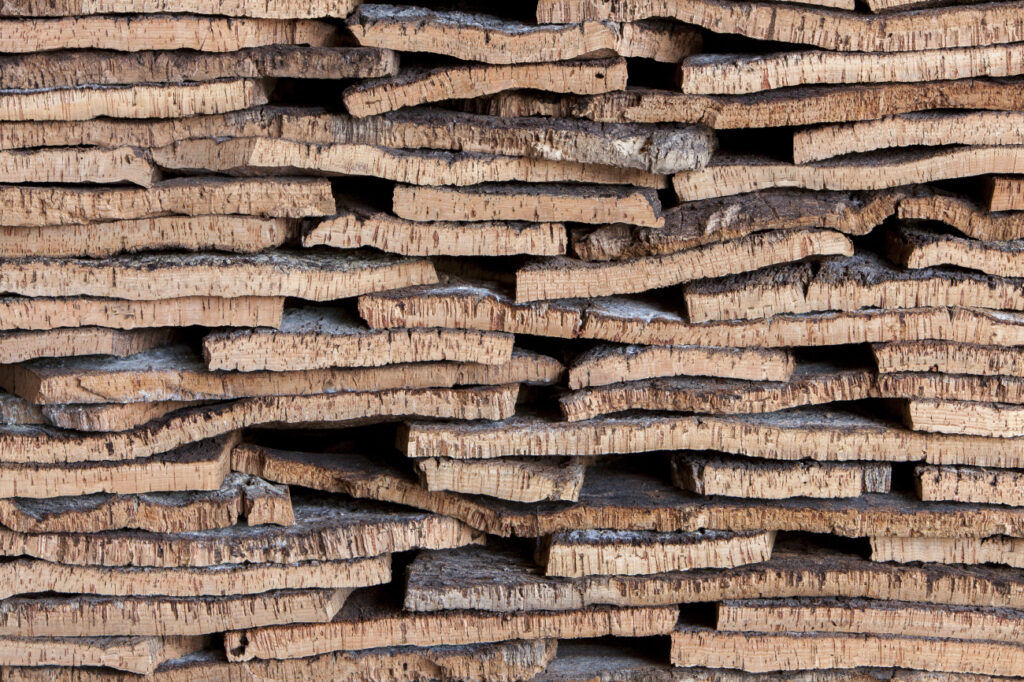A long-standing ally of mankind
For centuries, mankind has recognized the exceptional properties of cork oak and its bark. In ancient Greece, cork was mainly used to stopper amphorae containing olive oil and wine barrels, or to make fishing tackle.
Between the 15th and 16th centuries, the Portuguese favored cork oak for navigation and the parts most exposed to the elements, considering it the best material.
In the 16th century, German druggists rediscovered the virtues of cork as a bottle stopper.
The first cork factories were built around 1760.
In France, the monk Dom Pérignon used cork to seal the famous champagne wine that bears his name. Since then, the cork industry has gone from strength to strength.

An exceptional raw material
The choice of this raw material is by no means a matter of chance. Natural cork meets the requirements of renowned winemakers around the world and the expectations of the most demanding consumers.
Cork is distinguished by its impermeability, resulting from the counter-pressure exerted by the gases present in its cells and the presence of suberin.
The natural cork stopper is the best guarantee for preserving fine wines. In fact, cork stoppers allow wine to breathe over time, ensuring perfect ageing for wines requiring bottle maturation.
The quality of our raw materials is our primary commitment.
Cork, the plant material so carefully harvested by man, possesses unique qualities unrivalled to this day, including :
- Remarkably light
- High coefficient of friction
- Impermeability to liquids and low permeability to gases, allowing the wine to breathe and evolve.
- Unique elasticity and compressibility , guaranteeing a perfect seal when corked.
- Chemical stability, resistant to acid attack
- Rot-proof, ideal for storing liquids in humid environments
- Exceptional thermal and acoustic insulation
- Outstanding fire resistance and durability
- 100% natural composition, biodegradable and recyclable
- 309 grams, the amount of CO2 sequestered by a single cork stopper
- 800 million – that’s the number of cells in a single cork.
- 90% is the proportion of gas contained in cork cells

Cork oak
Scientific name: Quercus suber L.
Cork isn’t wood, it’s the bark of a tree: the cork oak. The cork oak is a unique tree, characterized by the natural regeneration of its bark after each harvest. The tree itself is never felled to obtain the cork, thus preserving the sustainability of this ecosystem.
Portugal stands out as the world’s leading producer of cork for stoppers, contributing over 50% of global production, closely followed by Spain, Morocco, northern Algeria and Tunisia.
A cork oak lives on average between 150 and 200 years, if the tree is regularly barked. When the tree reaches 35 years of age, the first layer of cork is extracted. However, it takes just over 18 years after the first harvest to obtain bark suitable for producing high-quality cork. Over its lifetime, a cork oak will experience between 12 and 15 harvests.
All the cork harvested is put to good use. The remainder is used in a wide variety of sectors, from footwear to decoration, furniture and even the aerospace industry.

Debarking cork oak, a very delicate activity
Debarking is a delicate , entirely manual craft. This painstaking operation is repeated at least every 9 years, between May and August.
Harvesting cork does not damage the tree, which continues to grow and produce cork for centuries. We don’t cut down trees to harvest their bark!
- The first debarking stage, known as “demasclage”, produces cork that cannot be used to make stoppers.
- The second debarking process produces a material with a regular structure, but still unsuitable for making corks, known as “first reproduction cork”.
- It’s only with the third and subsequent debarking that we obtain cork with properties suitable for the production of high-quality corks, what we refer to as “female cork.”

> Discover our manufacturing process
The cork stopper, symbol of quality and tradition, is the ultimate guarantor of the preservation and enjoyment of your favorite wines. This makes it all the more essential to choose quality corks to seal bottles destined to be kept for several years before being enjoyed.
The cork stopper plays an essential role in the aging of wine. Thanks to micro-oxygenation, it allows the wine’s flavors and aromas to develop over time, offering a unique and inimitable taste experience.
The cork stopper accompanies the life of the wine.